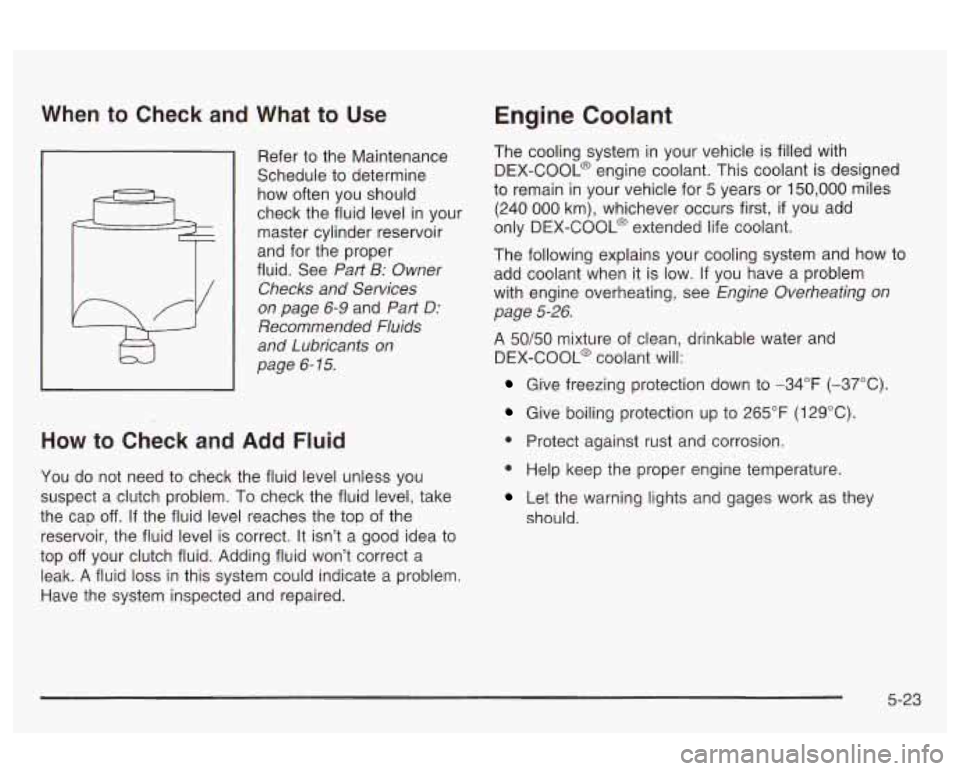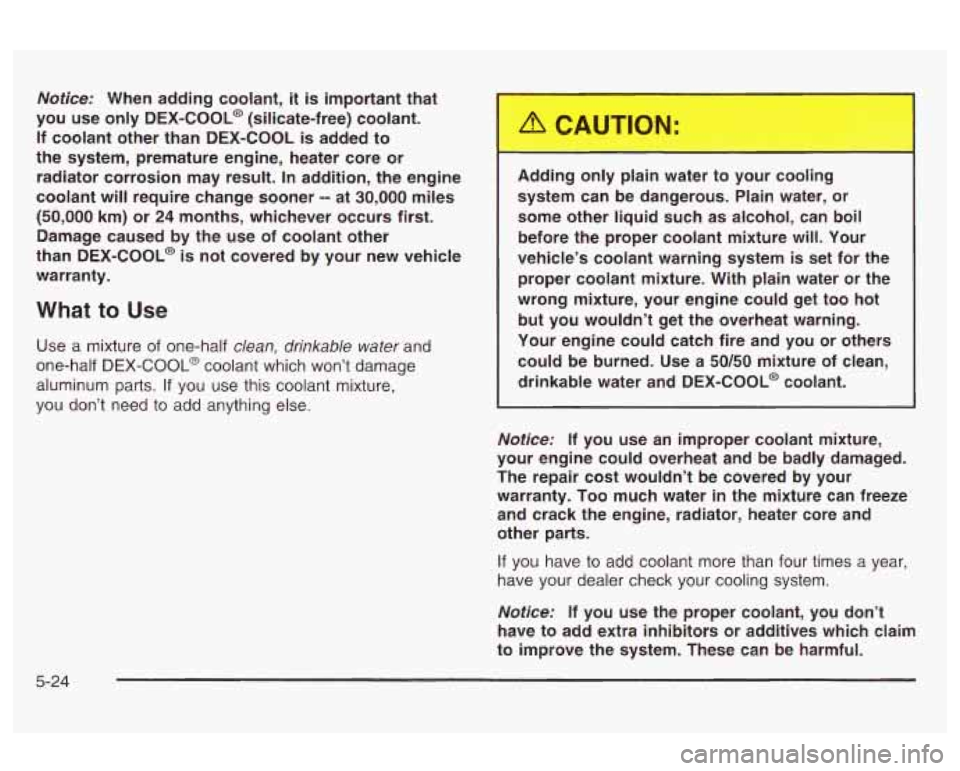Page 216 of 354

Section 5 Service and Appearance Care
Service ........................................................... -5-3
Doing Your Own Service Work ......................... 5.4
Adding Equipment to the Outside
of Your
Vehicle
..................................................... -5-4
Fuel
............................................................... -5-5
Gasoline Octane ........................................... -5-5
Gasoline Specifications .................................... 5.5
California Fuel .............................................. -5-6
Additives
...................................................... -5-6
Fuels in Foreign Countries
.............................. -5-6
Filling Your Tank
..................................... 5-7
Fillins a Portable Fuel Container .. ...... 5.8
the Hood
...................................................... 5-9
Hood Release .............................................. 5-10
Engine Compartment Overview ....................... 5-12
Engine Oil
.................................................. -5-1 5
Au'romaiic Transaxie Fiuia A-LL
Manual Transaxle Fluid .................................. 5-22
Checking
Things Under
Engine Air CleanedFilter
................................ 5-21 - ^^ .............................
Hydraulic Clutch ........................................... 5-22
Engine Overheating
....................................... 5-26
Cooling System
............................................ 5-28
Power Steering Fluid
..................................... 5-35
Windshield Washer Fluid
............ ............ -5-36
Brakes
...................................................... -5-38
Battery
........................................................ 5-41
Jump Starting
.............................................. 5-42
Engine Coolant
............................................. 5-23
Headlamp Aiming
........................................... 5-47
Bulb Replacement .......................................... 5-49
Haloger;
!3L;lbs .............................................. 5-49
Headlamps .................. .... ......... 5-49
Front Turn Signal and
Parking Lamps
.......... ......... 5-50
Center High-Mounted Stoplamp (CHMSL)
.................................... 5-50
Taillamps, Turn Signal, and Stoplamps ............ 5-50 n-.-~ n ..II-- nepmwzIIIe111 DUIU~ J-J 1 rc4 .......................................
5- 1
Page 224 of 354
Checking Things Under
the HnDd
An electric fan under the hood can start up
and injure you even when the engine
is not
running. Keep hands, clothing and tools away
from any underhood electric fan.
I-
I Thi ,s thai urn can - t on hot engir parts
and start a fire. These include
liquids like fuel,
oil, coolant, brake fluid, windshield washer and
other fluids, and plastic or rubber. You or
others could be burned. Be careful not to drop or
spill things that will burn onto a hot engine.
5-9
Page 228 of 354
A. Engine Coolant Surge Tank
B. Engine Oil Dipstick
C. Engine Oil Fill Cap
D. Brake Fluid Reservoir
E. Power Steering Fluid Reservoir F. Engine Compartment Fuse Block
G. Engine Air
Cleaner/Filter
H. Battery
I. Windshield Washer Fluid Reservoir
5-1 3
Page 229 of 354
When you open the hood on the 3400 V6 engine, you'll see the following:
A. Engine Coolant Surge Tank
B. Power Steering Fluid Reservoir
C. Engine Oil Fill Cap
D. Engine Oil Dipstick E.
Brake Fluid Reservoir
F. Engine Air Cleaner/Filter
G. Battery
H. Windshield Washer Fluid Reservoir
5-1 4
Page 238 of 354

When to Check and What to Use
Schedule to determine
how often you should
check the fluid level in your
master cylinder reservoir
and for the proper
fluid. See
Part B: Owner
Checks and Services
on page 6-9 and Part D:
Recommended Fluids
and Lubricants
on
page 6- 15.
How to Check and Add Fluid
You do not need to check the fluid level unless you
suspect a clutch problem. To check the fluid level, take
the cap
off. If the fluid level reaches the top of the
reservoir, the fluid level is correct. It isn’t a good idea to
top
off your clutch fluid. Adding fluid won’t correct a
leak. A fluid loss in this system could indicate a problem
Have the system inspected and repaired.
Engine Coolant
The cooling system in your vehicle is filled with
DEX-COOL@ engine coolant. This coolant is designed
to remain in your vehicle for 5 years or 150,000 miles
(240 000 km), whichever occurs first, if you add
only DEX-COOL@ extended life coolant.
The following explains your cooling system and how to
add coolant when
it is low. If you have a problem
with engine overheating, see
Engine Overheating on
page 5-26.
A 50/50 mixture of clean, drinkable water and
DEX-COOL@ coolant will:
Give freezing protection down to -34°F (-37°C).
Give boiling protection up to 265°F (1 29°C).
@ Protect against rust and corrosion.
@ Help keep the proper engine temperature.
Let the warning lights and gages work as they
should.
5-23
Page 239 of 354

Notice: When adding coolant, it is important that
you use only
DEX-COOL@ (silicate-free) coolant.
If coolant other than DEX-COOL is added to
the system, premature engine, heater core or
radiator corrosion may result. In addition, the engine
coolant will require change sooner
-- at 30,000 miles
(50,000 km) or 24 months, whichever occurs first.
Damage caused by the use of coolant other
than DEX-COOL@
is not covered by your new vehicle
warranty.
What to Use
Use a mixture of one-half clean, drinkable wafer and
one-half
DEX-COOL@ coolant which won’t damage
aluminum parts.
If you use this coolant mixture,
you don’t need to add anything else. Adding only plain water to your cooling
system can be dangerous. Plain
water, or
some other liquid such as alcohol, can boil
before the proper coolant mixture will. Your
vehicle’s coolant warning system is set for the proper coolant mixture.
With plain water or the
wrong mixture, your engine could get too hot
but you wouldn’t get
the overheat warning.
Your engine could catch fire and you or others
could be burned. Use a
50/50 mixture of clean,
drinkable water and DEX-COOL@ coolant.
Notice: If you use an improper coolant mixture,
your engine could overheat and be badly damaged.
The repair cost wouldn’t be covered by your
warranty.
Too much water in the mixture can freeze
and crack the engine, radiator, heater core and
other parts.
If you have to add coolant more than four times a year,
have your dealer check your cooling system.
Notice: If you use the proper coolant, you don’t
have to add extra inhibitors or additives which claim
to improve the system. These can be harmful.
5-24
Page 240 of 354
Checking Coolant
2.2L L4 ECOTEC Engine shown,
3400 V6 Engine similar
The coolant surge tank
is located in the engine
compartment on the passenger’s side of the vehicle.
See
Engine Compartment Overview on page 5-12
for more information on location. Turning
the surge tank pressure cap when the
engine and radiator are hot can allow steam
and scalding liquids to blow out and burn
you badly. Never turn the surge tank pressure
cap
- even a little - when the engine and
radiator are hot.
The vehicle must be on
a level surface. When your
mgine is cold, the coolant level should be at the
FULL
;OLD mark, or a little higher.
If the
low coolant light
comes on and stays on,
it
means you’re low on
engine coolant.
See
Low Coolant Warning Light on page 3-31 for more
nformation.
5-25
Page 241 of 354
Adding Coolant
If you need more coolant, add the proper DEX-COOL@
coolant mixture
at the surge tank, but only when the
engine is cool.
If the surge tank is empty, a special fill
procedure is necessary. See
Engine Overheating
on page
5-26 and “How to Add Coolant to the Coolant
Surge Tank under
Cooling System on page 5-28
for instructions.
Engine Overheating
You will find a coolant temperature gage and a low
coolant warning light on your vehicle’s instrument panel.
See
Engine Coolant Temperature Gage on page 3-31
and Low Coolant Warning Light on page 3-31.
If Steam Is Coming From Your Engine
1 --I can be -Jrned you s I coolant on hot
engine parts. Coolant contains ethylene glycol,
and it will burn if the engine parts are hot
enough. Don’t spill coolant on a hot engine.
I I
When replacing the pressure cap, make sure it is
hand-tight.
5-26